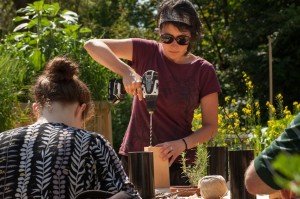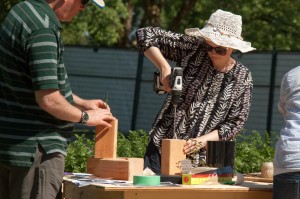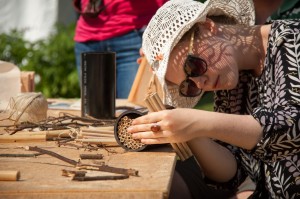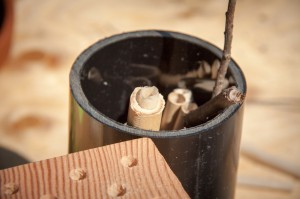Mason Bee Homes
Landscape Architect Christine Cooper joined us in the Moveable Feast garden to make mason bee homes.
Mason Bees are a non-aggressive bee that is native to British Columbia. Unlike honey bees they are solitary so they don’t live in hives or produce honey. These bees are opportunistic nesters, so they seek out narrow holes drilled into wood usually by woodpeckers or the long tube-like forms of dried plant stems.
They are known as mason bees for a good reason. Once, the females have mated they find a hole near a mud supply. They seal of the back of the hole with mud. They create a pollen ball and lay an egg upon it. They seal up the egg and pollen and then repeat the process until the hole is filled with multiple mud chambers. Female eggs are laid first, then the males. Mason bees will lay eggs until they die.
When the eggs hatch the larva will consume the pollen and then spin a cocoon out of silk. By fall a fully formed bee will be in the cocoon and waiting for the warm weather of spring before hatching.
Mason bees are prolific pollinators and it’s fairly simple to support them by building nesting sites. Christine showed us a couple different ways to construct a home. She also provided this useful guide.
To make a wooden home you’ll need the following materials:
– A piece of untreated fir or pine (not cedar). It needs to be large enough that you can drill 6″ holes
– An 5/16 auger bit or drill press to drill the holes
– parchment paper
Drill 6″ holes into the wood, then slide small rolls of parchment paper into each hole. The parchment paper makes it possible to pull out and safely store the mason bee cocoons over the winter. This will help to prevent damage to or predation of the cocoons. It also means that the home stays clean and can be used again the next year. For more detail visit Christine’s guide.
A simpler version involves using pre-made cardboard tubes. These tubes have one end already sealed. They can be bundled into a section of pipe to protect them from the rain. These tubes are for one time use only. They can be unravelled to remove the cocoons. These tubes are also 6″ in length which will ensure gender balance between the eggs.
Once you install your mason bee home in your yard, you’ll want to be sure that you provide nectar rich flowers for your bees. Mason bees collect pollen underneath their abdomens. They like bowl or spire shaped flowers. Orchard trees, blackberries and plants from the rose family all help to provide food for the bees.
You can also purchase mason bee cocoons to populate your home. A good source for mason bee cocoons and materials for housing is West Coast Seeds.
Need a reason to support native bee habitat? Watch this Ted Talk by apiarist Dennis vanEngelsdorp.




Leave a Reply